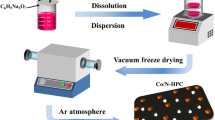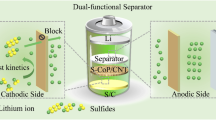Abstract
Lithium-sulfur batteries (LSBs) have a high theoretical specific capacity (1675 mAh/g) and are expected to replace lithium-ion batteries as a new generation of high-density energy storage devices. However, the existence of problems such as the “shuttle effect” causes an irreversible loss of LSB capacity. In view of this, carbon nanorods embedded with cobalt nanoparticles (Co-CNRs-CTAB) were successfully prepared through the high-temperature pyrolysis of prism-shaped polypyrrole loaded with zeolitic imidazolate framework-67 under the assistance of cetyltrimethylammonium bromide (CTAB), applied as commercial polypropylene (PP) separator modifiers to promote the rapid capture and redox conversion of soluble polysulfides for upgrading LSBs. The results show that the LSBs assembled with modified Co-CNRs-CTAB/PP separator have amazing electrochemical performance, involving a high initial mass specific capacity of 1091.8 mAh/g (1 C) and excellent cycling stability (594.7 mAh/g after 300 cycles at 3 C). Even at − 10 °C, the capacity attenuation of the LSBs per cycle is only 0.05% after 150 cycles. Therefore, this work provides an operationally simple and low-cost solution for improving the cycle life of LSBs.







Similar content being viewed by others
Data availability
No datasets were generated or analysed during the current study.
References
Song R, He J, Zhang C et al (2023) Multifunctional 3D multilayer cross-linked CNF-CNT interlayer for kinetically accelerated polysulfide trapping and conversion in lithium−sulfur batteries. J Solid State Electr 27:2395–2406
Umeshbabu E, Zheng B, Yang Y (2019) Recent progress in all-solid-state lithium−sulfur batteries using high Li-ion conductive solid electrolytes. Electrochem Energy R 2:199–230
Wang T, He J, Cheng X-B et al (2022) Strategies toward high-loading lithium–sulfur batteries. ACS Energy Lett 8:116–150
Wu N, Wang J, Liao C et al (2022) A flame retardant separator modified by MOFs-derived hybrid for safe and efficient Li-S batteries. J Energy Chem 64:372–384
Guo J, Xu Y, Wang C (2011) Sulfur-impregnated disordered carbon nanotubes cathode for lithium–sulfur batteries. Nano Lett 11:4288–4294
Wu K, Hu Y, Shen Z et al (2018) Highly efficient and green fabrication of a modified C nanofiber interlayer for high-performance Li–S batteries. J Mater Chem A 6:2693–2699
Huang J-Q, Zhuang T-Z, Zhang Q et al (2015) Permselective graphene oxide membrane for highly stable and anti-self-discharge lithium–sulfur batteries. ACS Nano 9:3002–3011
Su W, Feng W, Zhao Z et al (2023) MoWS2 promoted lithium polysulfide conversion for high-performance lithium-sulfur battery. Solid State Ionics 402:116376
Wang N, Zhang X, Ju Z et al (2021) Thickness-independent scalable high-performance Li-S batteries with high areal sulfur loading via electron-enriched carbon framework. Nat Commun 12:4519
Zhu Y, Zhang Y, Jin S et al (2023) Toward safe and high-performance lithium–sulfur batteries via polyimide nanosheets-modified separator. ACS Sustain Chem Eng 11:1434–1447
Jiang Y, Yang R, Liu Z et al (2024) Homogenous conduction: stable multifunctional gel polymer electrolyte for lithium-sulfur batteries. Colloids Surf A 680:132732
Zhang C, He Y, Wang Y et al (2021) CoFe2O4 nanoparticles loaded N-doped carbon nanofibers networks as electrocatalyst for enhancing redox kinetics in Li-S batteries. Appl Surf Sci 560:149908
Yao S, Zhang T, Ma C et al (2024) Comparative study of the electrochemical performances of different polyolefin separators in lithium/sulfur batteries. Mater Res Bull 171:112604
Zhu F, Liu J, Zhao H et al (2019) Preparation and performance of porous polyetherimide/Al2O3 separator for enhanced lithium-sulfur batteries. ChemElectroChem 6:2883–2890
Guo D, Ming F, Su H et al (2019) MXene based self-assembled cathode and antifouling separator for high-rate and dendrite-inhibited Li–S battery. Nano Energy 61:478–485
Song C-L, Li G-H, Yang Y et al (2020) 3D catalytic MOF-based nanocomposite as separator coatings for high-performance Li-S battery. Chem Eng J 381:122701
Zuo X, Zhen M, Wang C (2019) Ni@N-doped graphene nanosheets and CNTs hybrids modified separator as efficient polysulfide barrier for high-performance lithium sulfur batteries. Nano Res 12:829–836
Wang J, Cai W, Mu X et al (2021) Designing of multifunctional and flame retardant separator towards safer high-performance lithium-sulfur batteries. Nano Res 14:4865–4877
Zhu Y, Wang J, Wang Y et al (2022) A one-step deposition method to prepare separators with carbon soot loading for lithium-sulfur battery. Ionics 28:1693–1700
Balach J, Jaumann T, Klose M et al (2015) Functional mesoporous carbon-coated separator for long-life, high-energy lithium–sulfur batteries. Adv Funct Mater 25:5285–5291
Shen C, Li Y, Gong M et al (2021) Ultrathin cobalt phthalocyanine@graphene oxide layer-modified separator for stable lithium–sulfur batteries. ACS Appl Mater Inter 13:60046–60053
Qiu Y, Li W, Zhao W et al (2014) High-rate, ultralong cycle-life lithium/sulfur batteries enabled by nitrogen-doped graphene. Nano Lett 14:4821–4827
Chung S-H, Manthiram A (2014) High-performance Li–S batteries with an ultra-lightweight MWCNT-coated separator. J Phys Chem Lett 5:1978–1983
Guangmin Z, Songfeng et al (2014) A graphene–pure-sulfur sandwich structure for ultrafast, long-life lithium–sulfur batteries. Adv Mater 26:625–631
Ji X, Lee KT, Nazar LF (2009) A highly ordered nanostructured carbon–sulphur cathode for lithium–sulphur batteries. Nat Mater 8:500–506
Chung SH, Manthiram A (2014) Bifunctional separator with a light-weight carbon-coating for dynamically and statically stable lithium-sulfur batteries. Adv Funct Mater 24:5299–5306
Zhao Z, Li H, Cheng X (2021) Multifunctional FeP/spongy carbon modified separator with enhanced polysulfide immobilization and conversion for flame-retardant lithium-sulfur batteries. Chem Select 6:7098–7102
Zhang K, Jin L, Chen J et al (2024) Ketjen Black@Ce-MOF derived KB@CeO2-C as separator coating for lithium sulfur batteries. J Energy Storage 78:110006
Li W, Yang B, Pang R et al (2023) Polysulfide and li dendrite-blocking aramid nanofiber/metal–organic framework composite separators for advanced lithium–sulfur batteries. ACS Appl Nano Mater 6:1059–1071
Hong XJ, Song CL, Yang Y et al (2019) Cerium based metal-organic frameworks as an efficient separator coating catalyzing the conversion of polysulfides for high performance lithium-sulfur batteries. ACS Nano 13:1923–1931
Wang Z, Wang H, Zeng Z et al (2020) Metal-organic frameworks derived Bi2O2CO3/porous carbon nitride: a nanosized z-scheme systems with enhanced photocatalytic activity. Appl Catal B 267:118700
Li Z, Sun Y, Wu X et al (2022) Boosting adsorption and catalysis of polysulfides by multifunctional separator for lithium–sulfur batteries. ACS Energy Lett 7:4190–4197
Zhongsheng G (2021) Preparation of conductive polymer matrix and its composites and their applications in superacpacitors. [D]. Qilu University of Technology. https://doi.org/10.27278/d.cnki.gsdqc.2021.000223
Gu S, Xu S, Song X et al (2022) Electrostatic potential-induced Co–N4 active centers in a 2D conductive metal–organic framework for high-performance lithium–sulfur batteries. ACS Appl Mater Inter 14:50815–50826
Zhang Z, Chen C, Xu J et al (2022) Nanoporous cobalt–nitrogen–carbon catalyst-based multifunctional interlayer for enhanced Li–S battery performance. ACS Appl Energ Mater 5:4691–4697
Lin ZH, Li X, Song YF et al (2022) Highly graphitized porous carbon microspheres derived from copolymer of glucose and melamine for advanced electrodes. Part Part Syst Char 39:2200055
Gao Z, Zhang J, Mu T et al (2022) CTAB-assisted one-pot hydrothermal synthesis of Co085Se as a promising cathode material for magnesium ion battery. Mater Lett 328:133066
Xu CY, Du R, Yu CB et al (2022) Glucose-derived micro-mesoporous carbon spheres for high-performance lithium-sulfur batteries. Energy Fuels 37:1318–1326
Zang Y, Pei F, Huang JH et al (2018) Large-area preparation of crack-free crystalline microporous conductive membrane to upgrade high energy lithium-sulfur batteries. Adv Energy Mater 8:1802052
Wang Z, Cui C, Zhao Y et al (2023) VS4/MoS2 heterostructures grown along graphene to boost reaction kinetics and reversibility for high performance lithium-sulfur batteries. J Alloy Compd 967:171820
Niu SQ, Hu CC, Liu YY et al (2021) Nanoporous Co and N-codoped carbon composite derived from ZIF-67 for high-performance lithium-sulfur batteries. Nanomaterials 11:1910
Huang S, Wang Y, Hu J et al (2019) In situ-grown compressed NiCo2S4 barrier layer for efficient and durable polysulfide entrapment. Npg Asia Mater 11:55
Li Y, Lin S, Wang D et al (2020) Single atom array mimic on ultrathin MOF nanosheets boosts the safety and life of lithium–sulfur batteries. Adv Mater 32(8):1906722
Liu P, Yang W, Xiao F et al (2021) Efficient anchoring of polysulfides based on self-assembled Ti3C2Tx nanosheet-connected hollow Co(OH)2 nanotubes for lithium–sulfur batteries. ACS Appl Mater Inter 13:57285–57293
Liu Q, Han XT, Dou QY et al (2022) NiFe-layered double hydroxide nanosheets grafted onto carbon nanotubes for functional separator of lithium sulfur batteries. Int J Energ Res 46:9634–9642
He H, Xue Q, Liu L et al (2023) Mott Schottky heterojunction Co/CoSe2 electrocatalyst: achieved rapid conversion of polysulfides and Li2S deposition dissolution via built-in electric field interface effect. Chem Eng J 475:146126
Huang J, Dong SF (2022) Hierarchically porous titanium dioxide as efficient sulfur host for advanced lithium-sulfur batteries. Ionics 28:2775–2779
Funding
This work was supported financially by the National Natural Science Foundation of China (NSFC) (22208174), the New Colleges and Universities Twenty Foundational Projects of Jinan City (2021GXRC068), the Universities Youth Innovation Team Development Plan of Shandong Province (2023KJ140), the Natural Science Foundation of Shandong Province (ZR2022MB143), the Basic Research Projects of Science, Education, and Industry Integration Pilot Engineering of Qilu University of Technology (Shandong Academy of Sciences) (2023PY002), the Talent Research Projects of Qilu University of Technology (Shandong Academy of Sciences) (2023RCKY013), the 2023 Graduate Education and Teaching Reform Projects of Qilu University of Technology (Shandong Academy of Sciences) (24231601010415), and the Major Innovation Projects for Integrating Science, Education, and Industry of Qilu University of Technology (Shandong Academy of Sciences) (2022JBZ01-07).
Author information
Authors and Affiliations
Contributions
H. Y. drafted the work and revised it critically for important intellectual content; Y. Z. made substantial contributions to the analysis of data; Y. L. and X. L. made substantial contributions to the acquisition of data; M. L.1 made substantial contributions to the interpretation of the data; J. C. made substantial contributions to manuscript revision and experimental analysis. M. L.2 and L. J. made substantial contributions to the conception and design of the work.
Corresponding authors
Ethics declarations
Competing interests
The authors declare no competing interests.
Additional information
Publisher's Note
Springer Nature remains neutral with regard to jurisdictional claims in published maps and institutional affiliations.
Supplementary Information
Below is the link to the electronic supplementary material.
Rights and permissions
Springer Nature or its licensor (e.g. a society or other partner) holds exclusive rights to this article under a publishing agreement with the author(s) or other rightsholder(s); author self-archiving of the accepted manuscript version of this article is solely governed by the terms of such publishing agreement and applicable law.
About this article
Cite this article
Yuan, H., Zhang, Y., Lu, Y. et al. Nitrogen-doped carbon nanorods embedded with cobalt nanoparticles as separator coatings for high-performance lithium-sulfur batteries. Ionics (2024). https://doi.org/10.1007/s11581-024-05471-y
Received:
Revised:
Accepted:
Published:
DOI: https://doi.org/10.1007/s11581-024-05471-y




